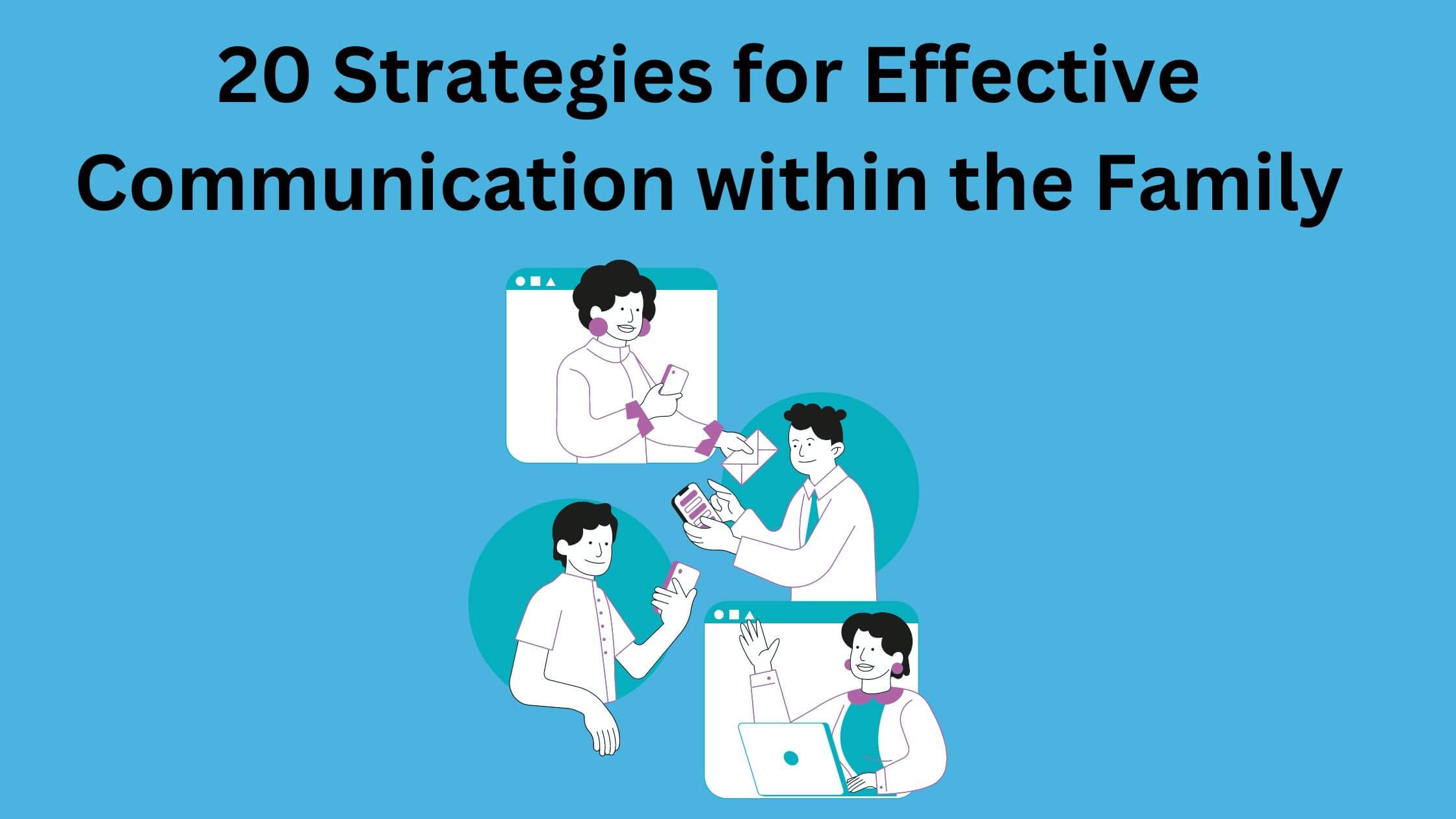Family communication is the cornerstone of healthy relationships, but it’s not always easy to talk to those who are closest to us.
Misunderstandings, miscommunications, and conflicts can occur frequently, making it essential to improve communication within the family. If left unaddressed, these issues can cause lasting damage to relationships and even lead to estrangement.
Fortunately, there are strategies for effective communication within the family that can help everyone feel heard, valued, and understood.
This article will explore some of the best practices for improving family communication, such as active listening, setting boundaries, and using “I” statements.
By implementing these strategies, families can build stronger bonds and manage disagreements in a respectful and productive way.
Tips to Promote Effective Communication Within the Family
1. Maintain Eye Contact
Maintaining eye contact is crucial to effective communication within the family. It ensures that everyone is engaged and present in the conversation, making them feel heard and understood.
This technique builds trust and respect among family members, as it shows that everyone’s opinions and thoughts are valued.
Eye contact should be combined with active listening techniques such as nodding and leaning forward, as it conveys a genuine interest in what the speaker has to say.
Avoiding distractions and paying attention to body language also help create a safe environment for communication.
By maintaining eye contact, families can improve their communication skills, leading to healthier relationships and stronger bonds.
Read more of our articles here.
2. Avoid Double Messages
Avoiding double messages is an important strategy for effective communication within the family.
As discussed in the previous sections, maintaining eye contact, listening carefully, and using two-way communication are all crucial elements of successful communication.
However, it’s also essential to ensure that your message is clear and consistent. Avoid sending mixed messages or contradicting yourself, as this can lead to confusion and misunderstandings.
Instead, be direct and concise, communicating one problem at a time. Remember to keep an open mind and validate the feelings of others, while also avoiding negative language and regulating your emotions.
By following these strategies, you can build trust and create a safe and open environment for communication within your family.
3. Listen Carefully
The importance of listening carefully for effective communication within the family cannot be overstated.
By giving undivided attention, the listener shows that they value the speaker and their thoughts.
It is also important to watch for nonverbal cues such as body language and facial expressions for a deeper understanding of what the speaker is trying to convey.
Active listening can also involve asking questions to clarify and better comprehend the message being communicated.
The use of simple language and speaking slowly can help the listener better understand and respond appropriately.
Overall, listening carefully is an essential skill to build stronger connections and improve communication within the family.
4. Validate Their Feelings
When communicating within the family, it’s important to validate everyone’s feelings, especially those of children.
This means acknowledging and accepting their emotions, even if you don’t agree with them. When children feel heard and understood, they are more likely to open up and communicate effectively.
To validate their feelings, you can say things like, “I hear that you’re upset,” or “I understand why you feel that way.”
By doing this, you show your child that their feelings matter and that you care about their well-being.
Validating their feelings also helps to build trust and strengthens the bond within the family. It’s an essential component of effective communication within the family.
Remember to communicate one problem at a time, listen carefully, and avoid negative language to create a safe environment for communication.
5. Communicate One Problem at a Time
When it comes to effective communication within the family, it’s important to take things one step at a time.
This means focusing on one problem or issue at a time, rather than overwhelming each other with a laundry list of concerns.
This helps to keep conversations productive and focused, allowing each family member to express their thoughts and feelings without distraction.
By taking the time to listen to each other’s concerns and working together to find solutions, families can build stronger relationships based on mutual understanding and respect.
And when communication is open and honest, everyone benefits. So the next time a problem arises, take a deep breath, stay calm, and remember that communication is key to building a happy, healthy family.
6. Build Trust
To effectively communicate within the family, building trust is crucial. Trust can be built by consistently communicating with transparency, behaving consistently, and dealing with issues in a timely manner.
It’s important to avoid keeping secrets and to honor commitments. When communication is transparent, it creates a safe environment for openness and honesty in the family.
Additionally, utilizing two-way communication and validating each other’s feelings can help build trust.
Keeping a long-term approach and being honest, even when admitting mistakes or wrongdoings, can also show family members that they can trust each other.
By building trust within the family, communication becomes easier and more effective, leading to stronger relationships.
7. Use Two-Way Communication
The key to effective communication within families is utilizing two-way communication. This means both parties are actively involved in delivering and receiving information while listening to each other’s thoughts and questions.
It’s important to use in-person communication to build a strong relationship and understanding between family members.
It’s suggested to speak slowly, use simple language, and watch for nonverbal communication to ensure understanding.
Good communication involves both listening and talking in ways that make children feel important, so family meals can be a great way to foster this kind of exchange.
The ultimate goal is to create a safe environment for communication, where people feel valued, heard, and understood.
8. Utilize Technology
In this day and age, utilizing technology is one of the most effective ways of communicating within the family.
It saves time, energy, and resources. For instance, teachers can communicate with parents using technology, sending emails, text messages, and video calls to discuss their child’s progress.
Technology also offers unlimited space for sharing valuable and informative resources that are beneficial to the family.
However, it is important to remember that technology should not replace face-to-face communication.
It is just another avenue to improve communication within the family. It is vital to consider the age of the family members and to tailor technology to their needs.
With effective use, technology can greatly enhance communication within the family.
9. Keep Children Feeling Important and Valued
The key to effective communication with children is to keep them feeling important and valued.
This means using both verbal and nonverbal cues such as maintaining eye contact, personal space, and hand gestures to show their presence and opinions matter.
Validation of their feelings is also crucial in building trust and encouraging openness and honesty in communication.
It is important to avoid negative language and instead uses positive reinforcement to build confidence and self-esteem in children.
Parents should actively listen to children and provide clarity and usefulness in communication, which helps children feel heard and understood.
By prioritizing communication as a way to make children feel important and valued, families can create a safe and positive environment for children to express their thoughts and feelings.
10. Understand the Complex Process of Communication
Understanding the complex process of communication is a crucial factor in effective family communication.
It involves being mindful of the different factors that influence how family members communicate, such as their unique personalities, cultures, and background.
It also requires paying attention to nonverbal cues like body language, which can convey hidden meanings.
When communicating, it is important to speak clearly and thoughtfully, avoiding negativity and double messages.
Additionally, active listening and validation of feelings can create an atmosphere of openness and honesty, thus strengthening the bond within the family.
Creating a safe environment where everyone feels valued and important will promote the two-way communication process, giving each family member an opportunity to voice their concerns and feelings.
With these strategies in place, families can navigate the complex process of communication successfully, strengthening their relationships and building trust.
11. Create a Safe Environment for Communication
To foster effective communication within the family, it is essential to create a safe environment for open and honest dialogue.
This can be achieved by avoiding negative language, building trust, and validating feelings.
Encouraging active listening and regulating emotions are also crucial to this process. Providing an environment where all family members feel valued and respected can help establish a foundation of trust and openness.
By creating a safe and supportive space, family members can communicate their thoughts and feelings without fear of judgment, leading to better relationships and stronger connections within the family unit.
12. Encourage Openness and Honesty
Encouraging openness and honesty is crucial for effective communication within families. Promoting an environment where children feel comfortable sharing their thoughts and feelings, builds trust and strengthens the bond.
Parents and guardians should strive to create a safe space for communication to take place, free from judgment or criticism.
Active listening and avoiding negative language are also important in fostering openness and honesty.
By validating family members’ feelings and understanding the complex process of communication, it helps everyone communicate one problem at a time.
Utilizing technology and maintaining eye contact are also helpful strategies in supporting two-way communication.
Overall, by prioritizing honesty, openness, caring, and trust, families can establish positive communication patterns that last a lifetime.
13. Practice Active Listening
In order to effectively communicate within the family, it’s important to practice active listening.
This means giving your full attention to the person speaking, letting them finish their thoughts without interrupting, and demonstrating that you understand their perspective by asking clarifying questions or summarizing what they said.
Active listening can help build trust and create a safe environment for communication, as well as encourage openness and honesty.
Remember to also avoid negative language and regulate emotions in order to facilitate productive discussions.
By utilizing these strategies, families can improve their communication and strengthen relationships.
14. Avoid Negative Language
In the pursuit of effective communication within the family, it’s important to avoid negative language. This means steering clear of blame, judgment, and criticism.
Instead, focus on using words that are encouraging, positive, and supportive. The goal is to build each other up, not tear each other down.
Remember to also validate the feelings of others and communicate one problem at a time. By using two-way communication and creating a safe environment, everyone can feel valued and important.
It’s equally important to regulate emotions and understand the complex process of communication.
Practicing active listening and avoiding negative language will undoubtedly lead to healthier and happier familial relationships.
Additionally, utilizing technology and keeping children in the loop are other effective strategies for maintaining open and honest communication.
15. Regulate Emotions
In addition to the previous strategies, regulating emotions is crucial for effective communication within the family.
This means taking the time to manage any strong emotions before engaging in a conversation.
Encouraging deep breathing or taking a walk before reacting can help calm down an individual who may be feeling overwhelmed.
It’s also important to validate each other’s emotions and practice active listening to show empathy and understanding.
By regulating emotions, family members can approach discussions in a calm and respectful manner, leading to more positive outcomes and strengthened relationships.
16. Encourage the Use of “I” Statements
Encouraging the use of “I” statements is a powerful tool that promotes effective communication within the family.
When family members use “I” messages, they are able to express how they feel without pointing fingers, blaming, or attacking others.
By focusing on their own emotions, family members can communicate their needs in a non-threatening manner, which can help create a safe and respectful environment.
Effective communication is key to building positive and healthy relationships within the family, and using “I” statements is an excellent strategy to facilitate this process.
By embracing this technique, family members can better understand one another’s perspectives and build a stronger bond that is built on trust, empathy, and respect.
17. Avoid Blame
Effective communication within the family is vital in promoting healthy relationships, and one way to accomplish this is to avoid blaming one another. The family is a complex social unit, and mistakes are bound to happen.
Avoiding blame helps to lessen the emotional response and encourages open communication instead.
This approach fosters a supportive and non-judgmental atmosphere where family members can freely express their thoughts and opinions.
It allows them to work together towards a solution rather than getting stuck in a cycle of blame and defensiveness.
When blame is taken out of the equation, families can come together, work through their issues, and improve their overall connection.
It is, therefore, essential for families to adopt a no-blame approach to promote effective communication and to build stronger familial bonds that can withstand any obstacle.
18. Recognize Nonverbal Cues
Recognizing nonverbal cues promotes effective communication within the family because it helps to understand what a person is truly conveying beyond just the words being spoken.
Positive nonverbal communication like smiles, body language, and tone of voice can improve relationships with children and guide them.
Parents can also show their children that they accept them through gestures, facial expressions, and other nonverbal behaviors.
Nonverbal communication like eye contact, use of gestures, touch, space, time, and facial expressions help family members get information from one another.
As relationships progress in terms of closeness and intimacy, nonverbal signals become a shorthand form of communicating, as information can be conveyed with a glance or gesture.
Paying attention to nonverbal cues can help to bridge perceived communication gaps and promote mutual understanding within the family.
Good nonverbal skills can help show love, respect, and empathy for one another. By recognizing nonverbal cues, families can achieve effective communication and strengthen their relationships.
19. Honor Differences
Honoring differences within the family can greatly promote effective communication. When family members are respectful and compassionate towards one another, even when they have differing opinions, there is an atmosphere of trust and openness that allows for honest communication.
This kind of communication can help family members to better understand and appreciate each other, thereby strengthening their relationships.
It is important to treat each family member equally and embrace the diversity of cultural and personal backgrounds.
By intentionally communicating with respect and kindness, families can work together towards common goals and resolve conflicts peacefully.
When families are able to communicate effectively, they can work together to accomplish great things and enjoy a higher quality of life.
20. Avoid Assumptions
Avoiding assumptions promotes effective communication within the family. It is essential to avoid making assumptions about each other’s thoughts, feelings, or anticipated behavior as none of us are mind readers.
By actively listening to one another, family members can understand exactly what the other person is trying to communicate.
It helps in avoiding unnecessary conflict, and has the potential to lead everyone down unintended paths.
Effective communication requires open and honest dialogue, active listening, and a willingness to understand different perspectives.
By avoiding assumptions and giving full attention to each other, families can strengthen their relationships and create a positive atmosphere where everyone feels heard and understood.
In this way, avoiding assumptions can promote effective communication within the family, leading to healthier relationships and stronger connections.
Conclusion
In conclusion, effective communication within the family is crucial for building strong and healthy relationships. To achieve this, it is necessary to establish clear communication strategies.
These strategies may include active listening, speaking clearly and honestly, showing empathy, avoiding distractions, and being respectful in our communication.
Family members should be encouraged to speak out about their feelings, thoughts, and opinions, as this enables them to communicate their needs and maintain an open dialogue.
It is also essential to promote a safe and non-judgmental environment within the family. By utilizing these strategies, the family can easily overcome communication barriers and strengthen their bonding.
It is important to remember that communication is a two-way street, and everyone should play an active role in ensuring that effective communication is promoted within the household.


